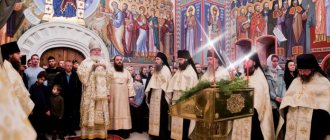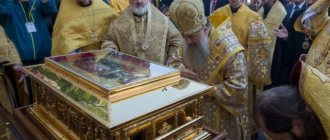Passion in Orthodoxy
Literally, the word “passion” is translated as sorrow and suffering. In everyday life it is used to mean “falling in love” and “unrequited love.” In the church it has a different meaning and is not at all connected with the loving suffering of Christ.
Passion is a special service during Lent, in which all prayers are dedicated to the suffering and death of Jesus on the cross. From the Church Slavonic language the word “passion” is translated as “passion”.
Passion is served only at the end of winter and spring, depending on the time of Lent. At this time, the priests conduct all funeral services, even on Sunday.
The black clothes they dress in symbolize mourning, a time of suffering.
Please note: Passions are served only on Sunday evenings.
Specifics of Lenten Liturgies
Another of the main features of Lenten services is that full Liturgies are not served in the church on weekdays. The only exception is for the Feast of the Annunciation, if it falls during the week. What is the reason for this specificity?
The fact is that Lent implies some limitation of a person in things that are joyful and pleasant for him. And this applies not only to physical oppression, but also to mental oppression. Of course, the main spiritual joy for a Christian is the Eucharist (communion), celebrated during the Divine Liturgy.
The full Liturgy is not celebrated so that we can re-evaluate this gift of God to man and have time to “hungry” for it. However, even here a small concession was made for the believers. Another feature of Lenten services is that on Wednesdays and Fridays, instead of the full Liturgy of the Presanctified Gifts, the Liturgy of the Presanctified Gifts .
Already from the name you can understand that people can partake of the pre-consecrated saints of the Body and Blood of Christ, which are usually prepared on Sunday. Such a Liturgy is never served again in the year.
Liturgies are celebrated in full rite on weekends. Moreover, on Sundays of Lent, in addition to Palm Sunday, the Liturgy of St. Basil the Great . It takes place only ten times a year. It differs from the Liturgy of John Chrysostom in the more extensive and deeper content of the secret prayers of the Eucharist, read by priests at the altar.
What is Passion for Lent?
Lent is a special time for every Christian. This is the longest fast of the year, dedicated to the suffering of Jesus Christ and his Resurrection.
This is the strictest fast, during which you cannot even eat fish. It is considered the heaviest, and not only because in spring there are not enough vitamins and bright colors. Simply, Lent is a time of worship dedicated to the suffering of Christ.
The exact start time has not been recorded. Every year Lent begins differently. It is believed that it depends on the lunar cycle. Therefore, every year it begins at a different time - immediately after Maslenitsa, celebrated in February, and sometimes in March.
Typically, Sunday is considered a holiday dedicated to Jesus Christ. If in Judaism Saturday was considered a day off, then Christians made Sunday a holiday, but the meaning of this day changes during Lent. At this time, Sunday becomes a reminder of the suffering of Christ, so passion is served in the evening.
In total, 4 passions are served every Sunday during Lent. But since in some churches the holiday of the Triumph of Orthodoxy is celebrated on the first Sunday, the Passion is not always served on the first Sunday. But during Lent, 4 passions are read in honor of the 4 Gospels, then Palm Sunday is celebrated the next Sunday, followed by Easter.
It is worth noting: in some churches the last passion is read not on Sunday, but on Friday.
There is an opinion that Passion is a late service borrowed from Catholics, but this is not true. The solemn and pathetic nature of the Catholic service has nothing to do with the Orthodox one. It is for this reason that at the beginning of the appearance of passion (15th century) it caused a lot of controversy and almost a schism in Orthodoxy, but today passion is considered a generally accepted worship service that does not raise any doubts about its correctness.
The Orthodox passion, in contrast to Catholic worship, is more strict and modest, in which every Christian internally experiences all the sufferings of Christ, sympathizes with Him, and does not show off his emotions.
Please note: this service is very strict, so you should not come to church in bright, provocative or festive clothes, as this contradicts the strict and mournful nature of the service. Bright perfume and provocative makeup are undesirable.
The penitential canon of Andrei Kritsky
From Monday to Thursday of the first week of Holy Pentecost, a special service is held in the evenings with the reading of the Penitential Canon. This is one of the most outstanding works of church hymnography, written by St. Andrew, Archbishop of Crete. In general church use, the canon was already known in the 10th century.
Why was this work called Great? This name is due not only to its large size (the canon is divided into four full parts), but also to the abundance of thoughts, comparisons and allusions from the Old and New Testaments.
The general mood of creation reflects the state of the soul, which bitterly mourns its sins. The same repentant mood is conveyed by the repeated refrain: Have mercy on me, O God, have mercy on me . On Thursday of the fifth week of Great Lent, at Matins, the canon of St. Andrew of Crete is read in its entirety at one time.
This service was called “Standing of Mary” in honor of the memory of the Venerable Mary of Egypt, which takes place this week. At the same time, the life of the holy ascetic, who spent forty years in the desert, is read in the temple. This service is the longest of all church services and lasts approximately five hours.
Passion course of service
During the Passion, the main point is reading the Gospel. There are 4 of them in total. This service is very strict and in some churches it is customary to stand with lit candles throughout the entire passion. At this time, mournful chants are heard, and then the Gospel is read.
During the service, there is a Crucifix in the middle of the temple, which everyone comes up to after the service and kisses.
The main prayers of the passion are dedicated to the suffering of Christ. During the service, the services of Friday, the day of the end of Christ’s earthly life, are also read. All prayers are dedicated to the suffering of Christ and Golgotha, events that are associated with the last days of Jesus’ earthly life.
Why are services long?
The period from the first week until the sixth Friday inclusive is called Holy Pentecost and is exactly 40 days. The seventh week is called Holy Week and stands out separately. The first fast service falls on the evening of the so-called Forgiveness Sunday , since the church day begins in the evening.
Church services of Lent differ primarily in their duration. Their goal is to set a person in a repentant mood, to prepare the soul for the meeting with the Risen Christ. This is achieved through intense prayer.
During the evening service of Great Lent, Great Compline is served instead of Small Compline. At Matins, the usual canon to the saint is replaced by three songs - special canons consisting of three songs. In addition, special hours, Lenten hours, . Proverbs are also heard at Vespers .
Particular attention in Lent is paid to reading the Psalter. This applies to both home and church prayer. During a week in the temple, the entire book is now read twice instead of once.
Gospels read at Passion
In Passion the 4 Gospels are read. At the first Passion, the Gospel of Matthew is read - chapters 26 and 27, dedicated to the suffering of Christ and the end of his earthly life. They describe the betrayal of Judas, the suffering of Christ and everything that happened afterwards.
During the next Passion, chapters 14 and 15 of the Gospel of Mark are read in church.
Chapters 23 and 22 of the Gospel of Luke are usually read during Passion 3, and during the last Passion, which occurs on Friday or Sunday, chapters 18 and 19 of the Gospel of John are read.
Lent memorial services
Three Saturdays of Great Lent in a row, starting with the second, are called parental memorial Saturdays . On these days, the funeral Liturgy of St. John Chrysostom and the Great Requiem Service are served. On the eve of Friday, a parastas is performed (funeral evening service with the reading of the 17th kathisma).
These are days of special remembrance of the dead. Such services are motivated by the fact that on weekdays of Lent there is no church commemoration of the departed, since the full Divine Liturgy is not celebrated. In order not to deprive our families of the Church’s prayers for them these days, parental memorial Saturdays were established.
Week of the Cross
Among other features of the services, one cannot fail to mention the third Sunday of this Lent. At the all-night vigil of this day, the Cross is brought out for worship by believers. At the same time the chant is sung:
We worship Your Cross, O Master, and we glorify Your holy resurrection.
The end of the third week marks the middle of Lent; half the journey has been completed. The cross is brought out to believers to strengthen the strength of those fasting, so that it is easier to go the rest of the way. Moreover, this tradition has its roots in Byzantium.
As you know, previously baptism was accepted there exclusively on Holy Saturday, before Easter. To strengthen the strength of the catechumens (preparing for baptism), the Cross was carried out in the middle of Lent. He remains in the temple until Friday, which is why the fourth week is also called “Worship of the Cross .
"Praise to the Blessed Virgin Mary"
Completely separate from all services is the so-called “Saturday of Akathist” , or “Praise of the Most Holy Theotokos” . It takes place on the fifth week of Holy Pentecost. At Matins, the akathist to the Mother of God “Rejoice, Bride of the Bride” .
This is the first and only akathist established by the Church Charter. It was written in honor of the protection of Constantinople by the Most Holy Theotokos from the invasion of foreigners in 626. To perform the service, the priests on this day go to the middle of the temple. The Akathist is read in parts, four times. After each part, a kontakion (short chant) is sung to “The Chosen Voivode” and the temple is censed.
In its atypical festivity for Lent, “Saturday of the Akathist” is similar to the Annunciation. And only in honor of the Most Holy Theotokos are two such great exceptions made during Lent.
As you can see, guard services have a huge meaning and diversity. In the last, Holy Week, they are even more spiritually saturated. This should be discussed separately. However, it makes sense, if possible, not to miss any of the most important services during Lent, because they will not be repeated this year.
Passion for passion. PRO ET CONTRA
So what kind of beast is passion? The hymns from Passion Week are played out... Neither this nor that: Passion Week is still far, far away, but here “Dividing My Robes for Yourself” is already sung. There is no such service in the Charter. And that's it.
From the Orthodox forum: Passion is a gross violation of the liturgical regulations of the Orthodox Church, which, unfortunately, is very rooted in our everyday life. Hegumen P. The greatest “prayerful mood and empathy” are evoked by the akathists “to Mother Matronushka” (they also read the akathist at the Passion)... Sometimes you think, maybe these akathists will serve on Sundays instead of the liturgy - at least the people will pray, and not study God knows than, interrupting to bow to the ground at “important moments.” P. At least passion evokes a more correct prayerful mood than the abstract Chesnokov or Matronushka... S.
So what kind of terrible beast is the passion service? Indeed, this is the latest Orthodox service in existence. Therefore, the Typikon (Charter of the Orthodox Church) does not know it. It was compiled in the first half of the 17th century. Kyiv Metropolitan Peter (Mogila) (1596 (97) - 1647; metropolitan since 1633) and was practiced first (from the 18th century) in the southwestern dioceses, and from now on. XX century spread widely throughout Russia. Passion is celebrated during Great Lent, on the 1st, 2nd, 3rd and 4th (or 2nd, 3rd, 4th and 5th) weeks (i.e. Sundays) or Fridays at evening services, Compline or Vespers. The number of passions corresponds to the number of evangelists - at these services the saving sufferings of the Lord Jesus Christ are remembered and after each passion the gospel narratives about this are read: on the first - the 26th and 27th chapters of Matthew, on the second - the 14th and 15th from Mark, on the third are the 22nd and 23rd from Luke, on the fourth are the 18th and 19th from John. In addition, some hymns from the service of Good Friday, the day of the Lord’s bodily death, are heard at the Passion. Thus, the stichera “Come, let us bless Joseph of ever-memorable” , which is sung while kissing the Shroud of Christ; Before the reading of the Gospel, the prokeimenon sounds : “Dividing My garments for yourself and casting lots for My clothing . The early rite of this service did not include any parts other than the Gospels and sermons, but popular piety added an akathist to them - the Cross of Christ or the Passion of the Lord. However, being a late work, from the point of view of the Rule, optional, to a certain extent similar to the Western passions (passio) according to Matthew (Mark, Luke, John), and even with an openly Latin name, the service of passion causes confusion among the people. So what is wrong with it?
Kutuzov Boris Pavlovich , headmaster (regent) of the Church of the Holy Image of the Savior Not Made by Hands on the territory of the former Spaso-Andronikov Monastery, one of the leading experts in the field of Znamenny singing: - You cannot serve the Passion. Have you read my book about church reforms of the 17th century? Much is clear from it; it was just republished last year. There is no need to serve the Passion now because it is a non-Orthodox occupation. The word “passion” itself is Latin, Catholic. And this service came to us from Western Uniates, that is, semi-Catholics. Secondly, what is passion now, how is it served? In each temple this happens in its own way, in different ways. But mostly the hymns from Holy Week are included. Neither this nor that: Holy Week is still far, far away, but here “Divide My Robes for Yourself” is already sung - I haven’t been going to such services for a long time and I think that there’s no need to go. There is religious exaltation going on there. They try to make everything more solemn: coming out with the Gospel, coming out with a deacon with a thick candle, and so on. What is happening is nothing more than exaltation—mostly of gullible grandmothers. And then we wonder why someone starts crowing at our services. They say: we need to reprimand her. No, there was no need to excite her at first - then there would be no need to reprimand her. In any case, passion is a non-Orthodox matter. There is no need to serve her. “But our rites have little in common with Catholic worship.” For example, it includes an akathist to the Passion of the Lord, written by St. Innocent of Kherson... - This is a broader question about akathists. In the Orthodox tradition, which the Old Believers very clearly preserve, there is only one Akathist according to the Charter - the Akathist to the Mother of God on Saturday of the fifth week of Great Lent - on Akathist Saturday. The MTR received a lot of correspondence on this issue. Filaret (Drozdov): at that time the issue of akathists was acute. They wrote to him: why such an avalanche of akathists? And he wrote: what is there to complain about? There is only one Akathist in the Charter - the Mother of God. It was as if he was pretending to be naive. And besides, in the prayer after this Akathist to the Mother of God it is said: “To you alone we offer this service.” That is, an akathist can only be addressed to the Mother of God. What have we achieved over the past three hundred years? They wrote an impenetrable, wavering sea of akathists. Moreover, this question was raised at the Synod in the 19th century, and the Synod ordered the removal of some akathists. At mtrp. Philaret has an article on this topic. He said that there were too many general expressions in them, as if they were written on the same block. Akathists were written by all and sundry. For example, Prince Gagarin is a completely non-church man, but he has gained experience. It was fashionable to write an akathist. In St. Petersburg he publishes the book “My Erotic Adventures in the Village,” and in another place he publishes his akathists. These are our authors of akathists. One archimandrite said - and I completely agree with him - that one should leave one Akathist - the Mother of God, as the Old Believers do, and simply burn all the rest. This is the most radical solution. And now what do we see? Akathists in monasteries. Well, should monks do this? Even St. Ignatius (Brianchaninov) said: akathists are for beginners. That is, this is a very liquid diluted milk. But introducing this into monastic work is a perversion of the monastic order. This is not why a monk goes to a monastery. - Still, the akathist included in the passion was written not by Prince Gagarin, but by St. Innocent. - So what of this? They also wrote besides him. Mtrp. Filaret said: is it good that anyone can write an akathist and give it to the general use of the Church? This is not good, because such authors as Prince Gagarin were also caught. Therefore, we need to focus on the Old Believers. They hold on to what has been preserved - pure Orthodoxy. — It’s not good when everyone writes akathists. But is it good to become so attached to a ritual, including the old one? Does the purity of faith depend on the aesthetics of the ritual? - No, the purity of faith depends on strict adherence to the Charter. There is no avalanche of Akathists in the Charter - there is only one Akathist - on Akathist Saturday. That's what mtrp was talking about. Filaret. So observe the Charter, and if other akathists can be read, then privately, and not for general use. You can come up with anything, and it’s very easy to provoke our flock. You never know that the grandmothers liked it and that they even ask to serve their passion. We must not follow the flock, but lead it to the priesthood and spiritual fathers. I am for the Charter - and for Donikonov’s. Then we won't have any questions.
In order to somehow confirm or dispel popular doubts, we turned for clarification to a specialist in the history of worship of the Russian Church, head. by the editors of Divine Services and Liturgics of the Central Scientific Center "Orthodox Encyclopedia", Associate Professor of the Church-Practical Department of the Moscow Academy of Arts, Deacon Mikhail Zheltov: From the point of view of the very structure of the service of passion, there are no elements in it that would be non-Orthodox in themselves or would not be borrowed directly from the Orthodox service: Akathist to the Passion of Christ (its history is a separate topic for discussion; but this is an akathist that has long been part of our tradition, which is present in many editions of the Prayer Book, Akathist Book, etc.), the Gospels taken from the Passion Services, prokeimenon and stichera - that’s what distinguishes passion from statutory vespers. The question of passion does not consist at all in the presence in its rite of elements alien to Orthodox worship, but in the fact that the charter knows nothing about its performance. However, the views on passion that are sometimes encountered are associated with two misconceptions. Misconception 1: Passion is an imitation of Bach's (or, more broadly, Lutheran) “Passion according to Matthew/John/Mark/Luke.” What does the Passion consist of? In short, they alternate between choral parts, parts of the “storyteller” (singer or reader), arias of various vocalists, through which the gospel text is conveyed to the listener; “Passion” seems to retell it by role. Therefore, even simply in terms of content, “Passion” has nothing in common with passion. Passion is an Orthodox liturgical form, vespers, into which some Orthodox chants are inserted. And “Passion” is a new (compared to the evening) form, which is a unique way of retelling and experiencing the Gospel narrative with the help of musical means. Misconception 2: passion is a harmful Catholic innovation; it creates exaltation. Is there a Catholic text in the Passion? And how can the text of the Gospel, the akathist to the Passion of Christ, which is printed in the Prayer Book, real passionate prokeimenon or stichera taken from the Triodion, create exaltation? After all, if they can’t, then there’s no problem, and if (supposedly) they can, do we really have to admit that exaltation is normal during Holy Week, but not during passion? Orthodox chants, elements of Orthodox worship, which always influence us gracefully, will not influence us in any other way during passion.
The emergence of passion
Omitting liturgical details and speaking only in general, if we examine the historical roots of passion, they go back to the 17th century. At this time, both here in the East and in the West, Christian spirituality placed a special emphasis on experiencing the Passion of Christ. Moreover, if we talk about the manifestation of this on Russian soil, then it is not necessary to connect this with the influence on us, say, of the Uniates or in general with the “Latin influence”, the reforms of Patriarch Nikon of Moscow or Emperor Peter the Great, etc. So, say, among the Old Believers The book “The Passion of the Christ” is very popular, first published even before Patriarch Nikon, that is, in an era of very wary attitude towards everything Western (although the book is based on Western models), and this book, in its content, is fully consistent with the spirit of the passions.
Therefore, the main objection to the celebration of passions is not the “Western influence”, “special exaltation” and the like allegedly present in them, but that it is illogical to disrupt the structure of Lenten services by introducing a service that includes very special hymns of Holy Week. Indeed, the problem is not that passion is an imitation of something: as we have found out, there is nothing non-Orthodox in this service, borrowed from somewhere that should not be borrowed from. The problem consists, firstly, in the deviation from the liturgical rules, which do not know such a service (however, modern practice deviates from the rules in many things, so from this point of view, this argument is not so fundamental); secondly and most importantly, in the violation of the order of the church year. The church year is a very important component of church life as a whole: it also has a rational, pedagogical meaning - we must experience a certain sequence of sacred memories; and mystical, spiritual meaning - for us it is precisely this, and not another, order of holidays and fasts that is important; and neither one nor the other significance of the structure of the church year should be exaggerated or minimized. In this sense, passion is out of place: suddenly, in the second week of Lent, we already find ourselves in Holy Week. This is why she can be criticized. But let us pay attention to the following fact: the charter requires that the entire Gospel be read in the first days of Holy Week on the clock. For what? Holy Week has a distinctly graphic character, and this makes it very different from the services of other days of the year. Each service marks some event in the history of the Passion of the Lord. During Holy Week, at Matins and Vespers, certain passages from the Gospel are read, which tell about the events that happened at the beginning of a particular day and at the end of the day. The gap between the corresponding events was filled, as we know from the Gospel, with some other words or deeds of the Savior. And so, in the first three days of Holy Week, the Lord taught in the temple. It is easy to guess that our Gospel readings on the clock during these three days, the Word of God itself sounding in the Orthodox church, represents the preaching of Christ - the Word of God - in the Old Testament temple. In this sense, the specific content of the readings of the hours (which specific Gospel beginnings sound) does not matter, unlike the Gospels of Matins and Vespers, where specific beginnings speak about specific events of Passion. The tradition of reading the Gospel during the first three days of Holy Week is historically relatively late; but in the minds of people it has turned into an obligatory element, and some transformation has also taken place: many now think that it is necessary not only to depict the sermon of Christ in the temple, but to be sure to read all the Gospels from beginning to end (or rather, almost to the end - the Gospel of John is not finished reading). Since it is difficult to do this in the first three days of Passion, since you will have to spend a lot of time in the temple (remember that this was the idea of those who introduced this practice: to depict the preaching of Christ in the temple from morning to evening, to depict extremely literally), then many begin to read the Gospels in advance, before Holy Week, during ordinary Lenten weeks. This practice is widespread in Russia today. (Another option for reduction is to subtract only one Gospel instead of all, but to retain its exclusive place in the hours of Holy Week alone: this is done, for example, in our theological schools, and this option is obviously more correct.) What what's happening? Essentially, the same as with passion: a violation of the church liturgical circle, a violation of its symbolism - after all, if we begin to read the Gospel on the clock, say, already from the 2nd week of Lent, then the unique symbolism of Passion becomes less clear . But this practice does not raise any questions. After all, in fact, there really is nothing terrible in the fact that the Gospel is read in advance, just like in the celebration of passion.
To be continued…








